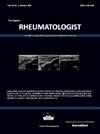Biologic of choice after secukinumab failure in psoriatic arthritis patient: Ixekizumab or interleukin-23 inhibitors – A retrospective study
IF 1
Q4 RHEUMATOLOGY
引用次数: 0
Abstract
Aim of the work
This study aimed to compare the clinical response to ixekizumab versus interleukin-23 inhibitors (IL23i) in psoriatic arthritis (PsA) patients who failed secukinumab treatment.
Patients and methods
A retrospective multi-center study included active PsA patients who experienced treatment failure with secukinumab and were subsequently treated with either ixekizumab or IL23i. Baseline demographics, including disease duration, domains involved and duration of secukinumab therapy were recorded. The disease activity in PsA (DAPSA) score and body surface area (BSA) were used to assess the effectiveness of the biologics in PsA.
Results
The mean age of the 25 patients was 49.4 ± 12.4 years, 15 females and 10 males with secukinumab failure were enrolled. 14 (56 %) patients switched to IL23i and 11 (44 %) to ixekizumab. The median duration of secukinumab exposure was 85.7 ± 56.2 weeks. The primary reason for switching was worsening joint and skin symptoms (52 %). Complete resolution of dactylitis (7/7) and enthesitis (5/5) was achieved with ixekizumab or IL23i. Patients with primary secukinumab failure showed PsA improvements regardless the treatment switch. Multivariate analysis identified comedication with conventional synthetic DMARDs and baseline DAPSA as predictors for achieving treatment targets in the ixekizumab group.
Conclusion
This study found that after secukinumab failure, the response to ixekizumab and IL23i was comparable, regardless of the type of therapeutic failure. By comparing these alternatives, it offers valuable insights into the evolving landscape of PsA management. Further prospective studies with larger sample sizes are needed to validate these findings and guide the selection of the optimal biologic therapy.
银屑病关节炎患者secukinumab失败后的生物学选择:伊谢珠单抗或白介素-23抑制剂-一项回顾性研究
本研究旨在比较ixekizumab与白细胞介素-23抑制剂(IL23i)在治疗失败的银屑病关节炎(PsA)患者中的临床反应。患者和方法一项回顾性多中心研究纳入了使用secukinumab治疗失败的活动性PsA患者,随后使用ixekizumab或IL23i治疗。记录基线人口统计数据,包括疾病持续时间、涉及的领域和secukinumab治疗持续时间。采用疾病活动性PsA (DAPSA)评分和体表面积(BSA)评价生物制剂对PsA的疗效。结果25例患者的平均年龄为49.4±12.4岁,其中女性15例,男性10例。14名(56%)患者改用IL23i, 11名(44%)患者改用ixekizumab。secukinumab暴露的中位持续时间为85.7±56.2周。换药的主要原因是关节和皮肤症状恶化(52%)。ixekizumab或IL23i完全解决了指炎(7/7)和鼻炎(5/5)。无论治疗切换,原发性secukinumab失败患者的PsA均有所改善。多变量分析发现,在ixekizumab组中,使用传统合成dmard和基线DAPSA作为实现治疗目标的预测因素。结论本研究发现,在secukinumab失败后,无论治疗失败类型如何,对ixekizumab和IL23i的反应具有可比性。通过比较这些替代方案,它为PsA管理的发展前景提供了有价值的见解。需要进一步的更大样本量的前瞻性研究来验证这些发现并指导最佳生物治疗的选择。
本文章由计算机程序翻译,如有差异,请以英文原文为准。
求助全文
约1分钟内获得全文
求助全文

 求助内容:
求助内容: 应助结果提醒方式:
应助结果提醒方式:


